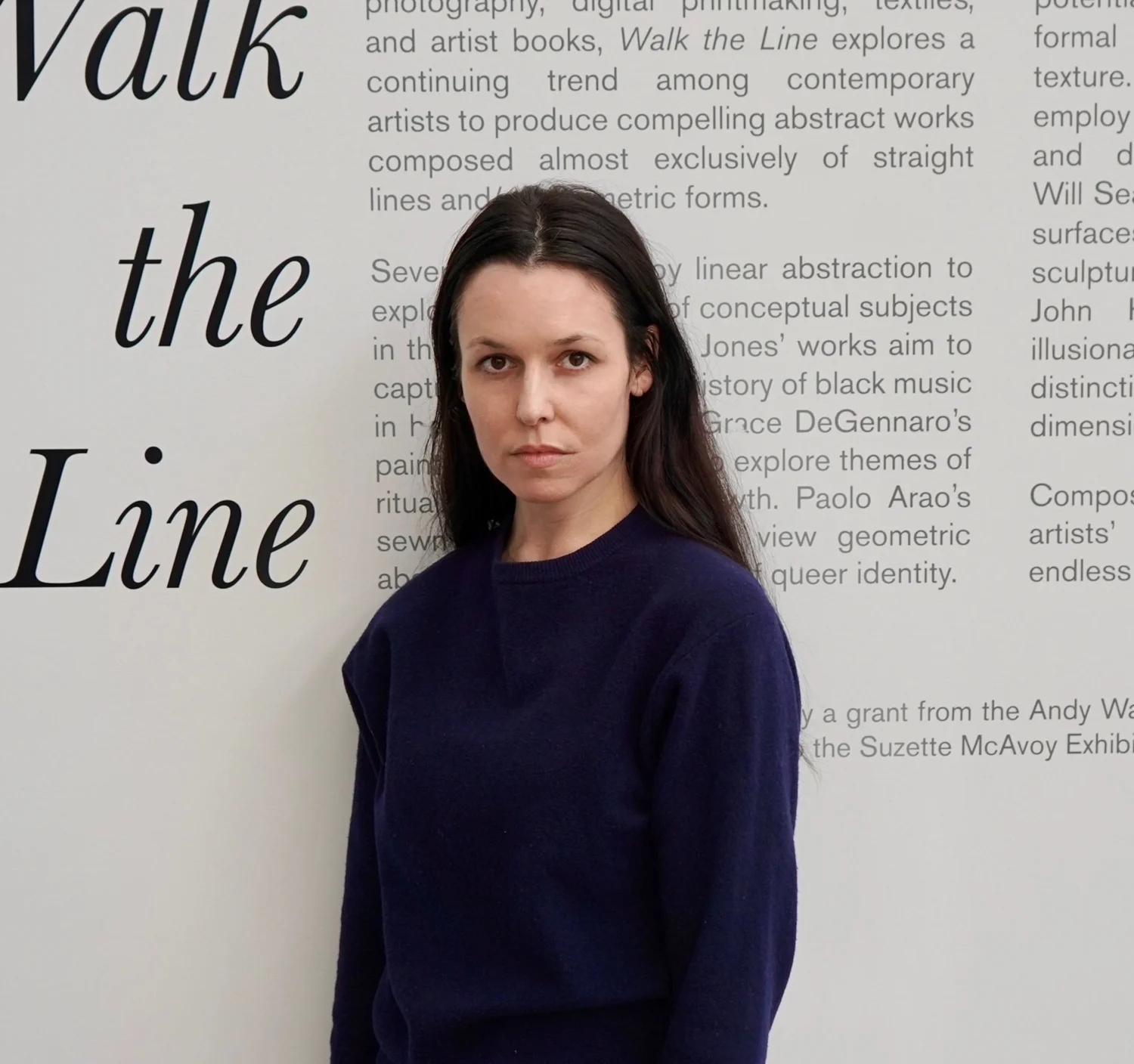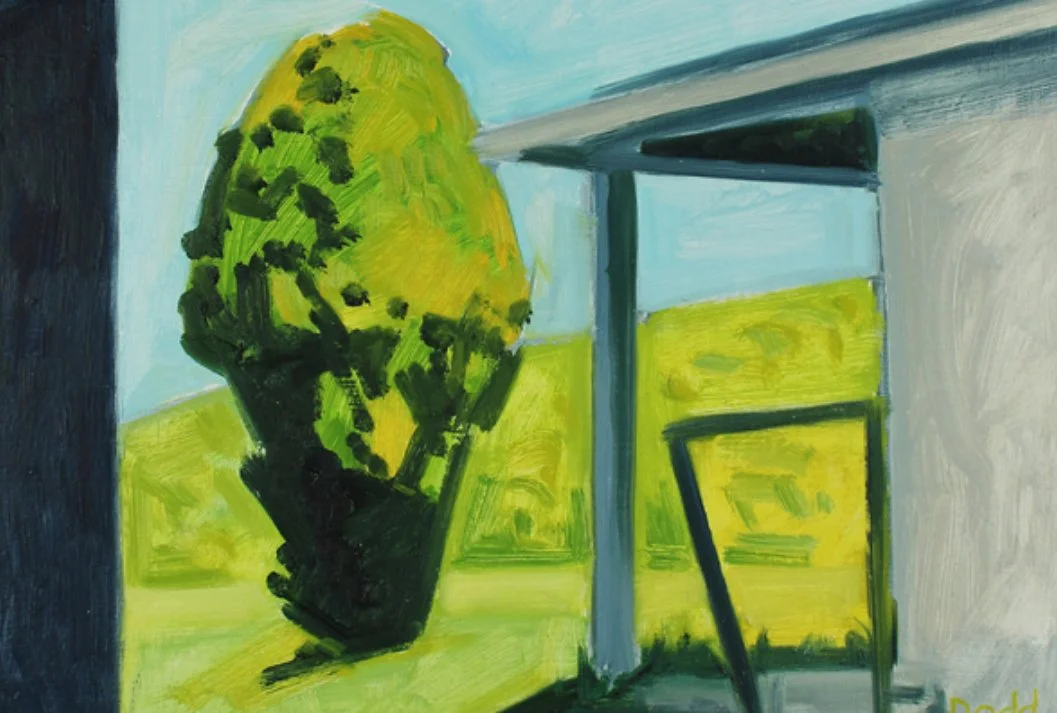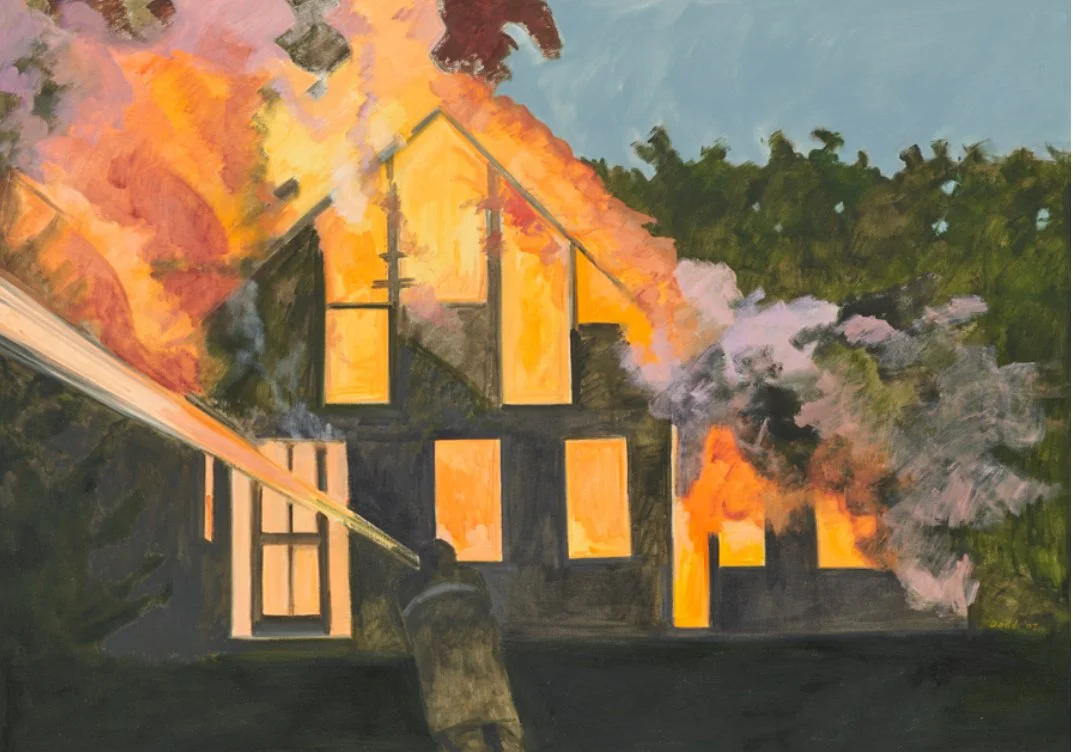Lois Dodd’s Incommunicable Language
Lois Dodd, Night House with Lit Window, 2012, oil on linen
It was at the moment when one of the owners of Caldbeck Gallery in Rockland, Jim Kinnealey, took me on a tour through the tight hallways of the second floor, between tall racks of countless Lois Dodd paintings, and I asked how Dodd chooses what to paint, that I realized I chose the wrong artist to write about. “She just paints what she sees,” he replied, tucking away another figure piece with minimal brushwork back into its place. What is there to say about work that has little interest in answering questions and less in asking them in the first place?
I recorded what details I could as we shuffled through the rooms, past decades of work looking back at me from crowded walls and well-stocked shelves. Pulling out a small rendering of a single thistle weed, he added she didn’t initially want to paint flowers because she didn’t want to be seen as a woman painting flowers. I had already read this about her. I knew it was the chosen subject of her neighbor in Maine, so she painted her neighbor painting flowers. Eventually she did paint poppies, amaryllis, cone flowers, pink scabiosa, queen anne’s lace. He pointed at works to be included in Dodd’s upcoming exhibition in the gallery this summer that feature her paintings of buildings, mostly small works on masonite panels, one dotted with candy-colored ice shacks against a frozen white lake, another the side of a barn, pink with light, sat next to its deep shadow.
Dodd attended Cooper Union art school from 1945-1948. In a Zoom interview with Barry Schwabsky of Art Forum, she recalls that her teachers worked mostly with observation which might have influenced her naturalistic approach, but quickly follows up by saying “who knows, it’s a strange thing” (Schwabsky, 2021), realizing the impossible task of understanding the genesis of one’s work. Dodd avoids claiming any certainties about painting. She also accepts her practice is hers and doesn’t necessarily apply to anyone else’s. While Dodd is hesitant to say why certain subjects interest her, she seems to find nothing but confidence in knowing what those subjects are when she sees them. What is most striking is Dodd’s trust in her own instinct. It appears to be the only thread that is constant in her varied body of work.
Some pieces are more abstract than others like, Chickens, 1958 and Standing Swimmer, 1966; many framed through windows seen from both the outside and the inside, such as Barn with White Square, 1991 and Painted Room, 1982, which is on view at the Farnsworth Art Museum. Others are more surprising like the series depicting a house on fire or her Liberty Painting in N.Y. Harbor, 2002, which keeps the twin towers in its skyline after they had been destroyed. In the seventy years she has been working, the course she has charted is her own, far from the opinions and directives of the art world and what it thinks is worthy of recording. Just as Jim Kinnealley put it, “she paints what she sees.”
I closed the door behind me as I stepped out of the gallery, back into the unrendered world. The pointed rooftops on Elm St. shaped the sky in Dodd’s geometry and sharp sunlight outlined each brick building with a narrow shadow. A slender tree pointed its buds toward every direction. As much as her interlocutors press for a deeper insight into her work, Dodd does little to sign off on others’ narratives. In an interview for the Brooklyn Rail, John Yau suggests that her painting which depicts her neighbor’s snow-covered house “evokes a certain moment, a certain aspect of America, that there is this kind of plainness that we like. It was the dream to own a house like that” (Yau, 2011). Dodd avoids Yau’s analysis by alerting him of a real estate opportunity: the house is for sale because the lady who lived in it died.
One aspect of her process Dodd is willing to admit is her prioritizing of form and light, which asks of her that she work quickly within nature’s organic rhythms. Most of her works, completed in one sitting, cooperate with nature’s ever-changing movement (Groff, 2020). In this way, I imagine that for Dodd, painting is simultaneously a way to keep herself inside of life as well as just outside of it, carefully observing the mysteries that lie generously before anyone who is willing to look closely.
Due to a new solo exhibition, the largest survey of her work to date, which opened in April at the Bruce Museum in Connecticut, Dodd, at 96 years old, has received a fair amount of press lately. The Washington Post recently published a piece where writer Sebastian Smee asks, “Why, if she is such a quietist, did she paint a house on fire?” (Smee, 23). He meditates on why she would render an “unfolding disaster,” not realizing that this had been a staged fire set by the fire department to conduct training.
I recorded what details I could as we shuffled through the rooms, past decades of work looking back at me from crowded walls and well-stocked shelves. Pulling out a small rendering of a single thistle weed, he added she didn’t initially want to paint flowers because she didn’t want to be seen as a woman painting flowers. I had already read this about her. I knew it was the chosen subject of her neighbor in Maine, so she painted her neighbor painting flowers. Eventually she did paint poppies, amaryllis, cone flowers, pink scabiosa, queen anne’s lace. He pointed at works to be included in Dodd’s upcoming exhibition in the gallery this summer that feature her paintings of buildings, mostly small works on masonite panels, one dotted with candy-colored ice shacks against a frozen white lake, another the side of a barn, pink with light, sat next to its deep shadow.
To be honest, I have more in common with these journalists' line of thinking than with Dodd’s way of being in the world. When I learned both of her parents had died before she was 15 – her mom of cancer and her father at sea as a merchant marine in World War II (Hilarie, 2023). I wanted to interpret her and understand how that experience finds its way onto her linen canvases and masonite panels.
In Smee’s Washington Post article, he cites an essay written by Yau included in the catalogue for Dodd’s 2012 exhibition, which I will use again here; “John Yau connected her many paintings of windows with a Zen Buddhist precept attributed to the 9th and 10th century Chan (or Zen) Buddhist master Yunmen: ‘Every day is a good day.’ Dodd was expert, he meant, at reporting on everyday-ness, on those moments when there is, in effect, nothing to report, and finding goodness in that” (Smee, 23). It is a paradox how someone as straightforward as Lois Dodd is also entirely mysterious. However, on second thought, what is more of a mystery to human beings than everydayness?
At the end of my research, I listened to one last Zoom interview where the interviewer asks a final question about living and working as a female artist and mother in a male-dominated art world. Lois responds:
It’s hard to know what advice to give somebody, except, I think somehow if you have to paint in order to feel like you're human, you almost have to do it no matter how much opposition you suffer. I was very fortunate in a way, in a horrible way – both my parents died by the time I was in Cooper Union. I was never sure they would have approved of me going to a place like that. That made it easier to do what I felt I really wanted to do no matter what terrible end I might end up at. (Schwabsky, 2021)
It seems, to me, this revelation is as close as I will come to knowing the forces behind Dodd’s work, where she has developed a language that is, at once, her own and in conversation with the shifting world around her. She lets herself be known by painting the incommunicable experience of being alive where there are no certainties – just thistle weeds, chickens, pink light on the side of a barn and the moon at night.
Lois Dodd, Burning House, Night, with Fireman, 2007, oil on linen
References
Hilarie (2023) Her views from close up are on everyone's Radar, The New York Times. The New York Times. Available at: https://www.nytimes.com/2023/03/31/arts/design/lois-dodd-bruce-museum-artist.html (Accessed: May 4, 2023).
Groff (2020) Conversation with Lois Dodd, Painting Perceptions. Available at: https://paintingperceptions.com/conversation-with-lois-dodd/ (Accessed: May 4, 2023).
NSE #413 | Lois Dodd with Barry Schwabsky (2021) YouTube. YouTube. Available at: https://m.youtube.com/watch?v=jYPN_XRes1k (Accessed: May 4, 2023).
Smee, S. (2023) Perspective | she painted the stillness, even with a house on fire, The Washington Post. WP Company. Available at: https://www.washingtonpost.com/arts-entertainment/interactive/2023/lois-dodd-burning-house-night/ (Accessed: May 4, 2023).
Yau, J. (2011) Lois Dodd with John Yau, The Brooklyn Rail. Available at: https://brooklynrail.org/2011/02/art/lois-dodd-with-john-yau (Accessed: May 4, 2023).



